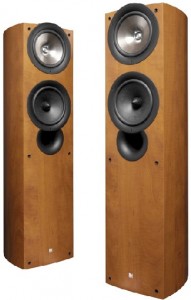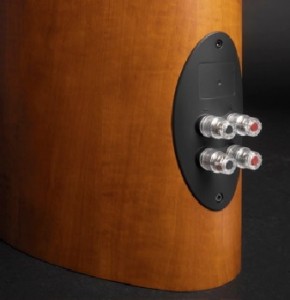KEF has a long history, as far as I can remember they where there. In the 80’s you mostly got 4 choices of speakers (at least in Canada): KEF, B&W, Quads and Paradigm. A lot of friends of mine bought the reference line at this time (mainly on the used market but who cares). I have a vivid memory when I bought a pair, this was the time they introduced the coaxial driver; tweeter in the centre of the midrange driver. I’ve listened to a lot of speakers at that time and bring home a pair of C25/SW200 mini-monitor & passive subs package. They had the dynamics I was looking for at that time and their coaxial drivers were not fine tuned. I was 15, worked hard to buy them but still have them today although heavily modified. To my amazement, I haven’t found anything below 2000$ that sound better.
Specifications :
- 6th Generation Uni-Q array with Neodymium magnets
- Improved “Titanium” finish, “long throw”160mm (6.5in) Uni-Q driver with redesigned 19mm (0.75in)
- Aluminium dome tweeter.
- Full 3 way floorstanding design
- Reference Series inspired (fully curved cabinet design)
- Improved Crossover design and Bi-Wire terminal panel.
- OFC cable terminal links
- Magnetically shielded.
- Closed box loaded midrange
Fast forward a moment, I’m now 32 reviewing for this magazine in part because of these famous KEFs. The technology pushed forward (inflation too… sadly).
KEF iQ7 review
Let me tell you that I have been amazed the latest iQ line. They pushed the coaxial mid/tweeter arrangement as far as they could for a reasonable speaker line (don’t listen to their new Reference line-up, it’s gonna cost you… as least you’ll be able to tell your wife it’s my fault). They pushed the technology, the iQ line is the result of a lot of efforts and they have the money to do a lot of research as they sell worldwide. For example, the ¾’’ aluminium dome tweeter inserted in the centre of the 6-1/2’’ titanium midrange driver goes up to 40kHz. For the accounting department or to give yourself an argument for your wife, the cheapest supertweeter reaching this limit retails for 399$. The fully curved cabinet helps reducing standing waves and is good looking. It’s available in black, apple, maple or walnut finish so your wife can choose the look she want… This is a laminated MDF construction complete with internal bracing reducing panel resonances, tap them, you’ll know they achieve their goal. I took home the iQ7 because it has another 6-1/2’’ low frequency transducer with front port (foam insert also supplied) that is supposed to go down to 40Hz (-3dB). Their sensitivity is rated at 90dB, 8Ω impedance; 15W will drive them easily.
So far so good but I really got to complain now. After all KEF research, they come out with 1) bi-wire which is good but only accept banana connectivity (CE badge obligation) and to push things even faster 2) they provide good looking but cheap sounding jumpers. I must say they deserve a lot better.
You should also understand that when you shop for that kind of money, the 1000$ full range speaker, the first thing you should listen is no identifiable mistake in the reproduced sound. This is a simple thing but a lot of audiophiles get caught at the dealer because the speaker or component they listen to has some great attribute. Normally it’s an exaggerated treble that help the sound become more vivid. You really got to watch out for this type of sound because it’s soon wears you out and demand another component ‘upgrade’. This can be ignored in the case of a dull sounding system which is quite rare. The iQ7 sits on the good side of the fence.
Now I hope you’re ready for the real fun. Soundstage is the name of the game here. As strange has it may seems, Tool’s ‘Eulogy’ from Aenima (BMG/Zoo 61422-31087-2) is part of my 5 acid tests to reckon if a component is worth buying. You should look for two things; the first is a decaying pad starting at 0:14 that can show instrument decay and resolution, the second at 1:00 and involves a strange percussive sound with great attack and panning effect. This panning effect is especially difficult to reproduce correctly, in most affordable systems, it will appear left, centre and right but in the good ones, the soundstage is stable and this sound moves freely between speakers with a lot more gradations from left to right.
Now a word on placement: it’s the easiest speaker I’ve ever come across that can reproduce great things form a huge variety of location. Even if you’re restrained in placement possibilities, the soundstage remains good and the foam inserts give you additional choices for the bass blend. The starting point is really to get the weight and definition in the bass department. The rest is almost history as long as you play with toe-in aiming a couple of foot behind your head. My room is 22’x 15’ and they had no problem filling it. I must admit for sheer bass power that I would have liked to try their bigger brother iQ9 with another 6-1/2’’ woofer and 1dB more efficient at Charley’s place. For your information, the Cayin AT/MT-88 tube integrated amp (22W triode / 45W ultralinear) feeding the iQ7 never pass the 1/3 volume mark en in triode mode in a big room so most amp will probably meet the KEFs demands. Frequency response is quite good, no significant deviation from neutrality. Engineers have done a great job with the crossover; earlier incarnations of the coaxial drivers where suspicious to say the least. I heard frequencies jumps out, instruments changing size and hardness at crossover point. Maybe it’s the new materials but now everything seems continuous. This coherence puts the iQ7 in the party speaker class. This characteristic signifies that the sweet spot is quite large; you can move a couple of foot without significant acoustical changes. More than one audiophile can listen seriously at the same time.
My tastes in music are very wide: classical, jazz, pop, hip-hop, electronic, industrial, metal, if the emotion is there, I’ll probably like it. I’ve throwned about everything at the iQ7 and nothing sounded bad. It’s not a one kind of music speaker; it almost forces you to acquire new tastes.
Dynamically they are quite good for the price. You get good impact, you can do better but prices skyrocket. Massenet Le Cid ballet music on gold disc (Klavier/Cisco GCD8002) was very well reproduced. It’s a very dense album with lots of instruments interactions beautifully interpreted and recorded in a majestic way. It sounded great with the KEFs without any sign of confusion even in complex passages which is quite a feat because I heard speakers costing in multiple of their price getting embarrassed.
They reproduce percussions with terrific abilities. Manu Katche percussions on Peter Gabriel Secret World Live album (Geffen GEFD2-24722) had snap, precision and good spatial qualities, especially from a live pop album. Tony Levin bass is masterful. Great lines, he knows when he can put his genius and when he has to retreat to simply serve the band. It doesn’t do PRAT the way the components can but it’s good.
Transparency is great with lot of details and from a convincing presentation. If you push them at high volumes (as far as I can go without being painful), hardness at 2kHz will appear but you’ll never notice it at normal listening volumes. What’s more, no cabinet sound. Music don’t seem to emerge from boxes.
With high frequency specified at 40kHz, you expect detail and extension. You get it, no nasties or colorations up that range. It’s sweet when the music is recorded that way but can be aggressive when it needs to be. A great mix. At the other extreme, kick drums had fast impact with weight behind them. Bass line had extension, pitch definition and where easy to follow. No one note bass here.
If this all sound as I liked the iQ7, well I’m guilty. I love them. Except for the binding post, they do everything at least very good. You can always do better overall but you’ll have to shop in another price bracket. Or you can look at them the other way around: but them for the long term while you can upgrade the rest of your system with much more expensive components before you’ll have to replace them.
 from affordableaudio, By Charles Painchaud
from affordableaudio, By Charles Painchaud



great review, great praise for my first “audiophile” speakers, that i too also still have. (zero upgrades) Love these speakers and likely never part with them, they are like old friends now and have never let me down! I love your review for another reason that is near and dear to me and that is your great taste in music namely your love for Tools Eulogly!! I am a HUGE Tool fan and Eulogy is such a great test for any speaker in my opinion. I think almost any of there songs is a great test due to the complexity and precision of every track they have ever released!! shout out to KEF, shout out to tool!!! I like your style friend, keep on keeping on!